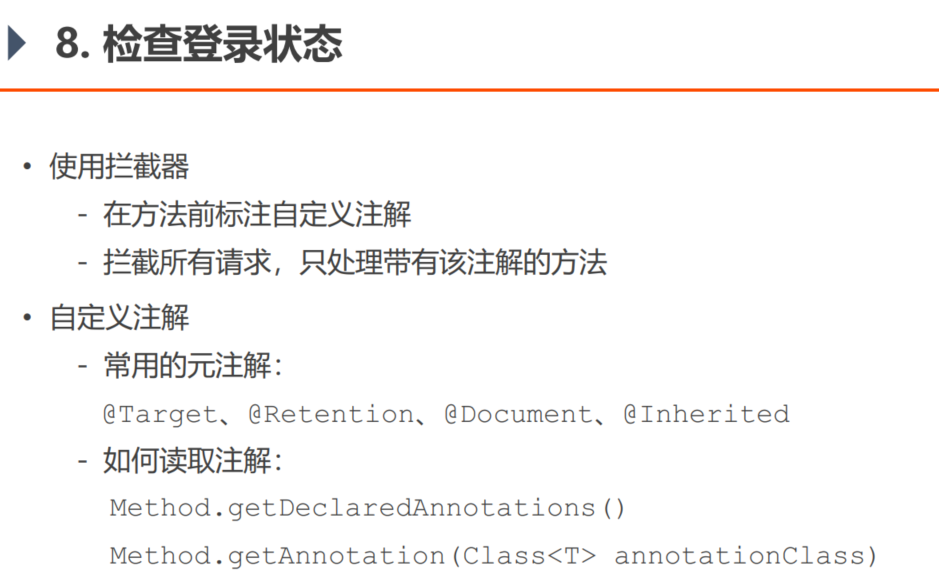
为何要检查状态?
用户未登录情况下,也可以访问setting界面。修改头像信息。这显然是不合理的。
应该在服务端有个判断,登录可以访问,未登录拒绝。多请求相同逻辑,使用拦截器Interceptor。
拦截器需要做配置,配置类实现WebMvcConfig接口。 现在通过另一种方式实现————注解的方式。
元注解:
-
@Target 声明自定义注解可以作为(类/方法)上
-
@Retention 声明自定义注解作用时间(编译有效?运行有效?)
-
@Document 声明自定义注解在在生成文档的时是否应该被加入
-
@Inherited 指定继承时子类是否继承父类的注解
反射调用:
-
Method.getDeclaredAnnotations() 获取这个方法至上的所有注解
-
Method.getAnnotation(Class<T> annotationClass) 获取指定类型的注解
示例:
- 自定义注解:(新建annotation包,并在其下建立LoginRequire注解,建立时选择注解而非类。用来判断是否登录)
/** * 注解作用判断是否已经登录 */ @Target(ElementType.METHOD) @Retention(RetentionPolicy.RUNTIME) public @interface LoginRequired { }
作用于方法,在运行时起作用。
- 将注解应用到对应的方法中去。
我们判断当前有两个界面需要判断用户是否登录。一个是Setting界面, 另一个是 处理上传文件的请求。将其注解上去。
@LoginRequired @RequestMapping(path = "/setting", method = RequestMethod.GET) public String getSettingPage(){ return "/site/setting"; } /** * 处理上传文件的请求 */ @LoginRequired @RequestMapping(path = "/upload", method = RequestMethod.POST) public String uploadHeader (MultipartFile headerImg, Model model){....}
- 写拦截器Loginrequire,实现HandlerInterceptor接口。
根据需求,在Controller前拦截,因此使用preHandel方法。
Object是我们拦截的目标,需要判断他是不是方法。 handler instanceof HandlerMethod
通过方法的反射获取指定类型的注解。 method.getAnnotation(LoginRequired.class)
如果未登录访问量需要登录才能访问的界面,就对他进行重定向。 response.sendRedirect();
@Component public class LoginRequiredIntercepter implements HandlerInterceptor { @Autowired HostHolder hostHolder; @Override public boolean preHandle(HttpServletRequest request, HttpServletResponse response, Object handler) throws Exception { //object 是我们拦截的目标 if (handler instanceof HandlerMethod){ HandlerMethod handlerMethod = (HandlerMethod) handler; Method method = handlerMethod.getMethod(); LoginRequired loginRequired = method.getAnnotation(LoginRequired.class); if(loginRequired != null && hostHolder.getUser()==null){ response.sendRedirect(request.getContextPath()+"/login"); return false; } } return true; } }
- 配置拦截器。(这里主要是完成对静态资源访问的不拦截)
@Configuration public class WebMvcConfig implements WebMvcConfigurer { @Autowired private AlphaInterceptor alphaInterceptor; @Autowired private LoginTicketIntercepter loginTicketIntercepter; @Autowired private LoginRequiredIntercepter loginRequiredIntercepter; @Override public void addInterceptors(InterceptorRegistry registry) { registry.addInterceptor(alphaInterceptor) //拦截一切请求 .excludePathPatterns("/*/*.css","/*/*.js","/*/*.png","/*/*.jpg","/*/*.jpeg") //排除访问静态资源,所有目录下的cs文件 .addPathPatterns("/register","/login"); //拦截指定路径及其下的页面 registry.addInterceptor(loginTicketIntercepter) .excludePathPatterns("/*/*.css","/*/*.js","/*/*.png","/*/*.jpg","/*/*.jpeg"); registry.addInterceptor(loginRequiredIntercepter) .excludePathPatterns("/*/*.css","/*/*.js","/*/*.png","/*/*.jpg","/*/*.jpeg"); } }
完成这些之后,未登录状态下直接访问setting时,就会自动跳转到login界面。安全!
遇错:
@Inherited用于描述该注解是否可以被其他注解继承。 (错误)
如果一个类用上了@Inherited修饰的注解,那么其子类也会继承这个注解。
但是:
接口用上个@Inherited修饰的注解,其实现类不会继承这个注解
父类的方法用了@Inherited修饰的注解,子类也不会继承这个注解